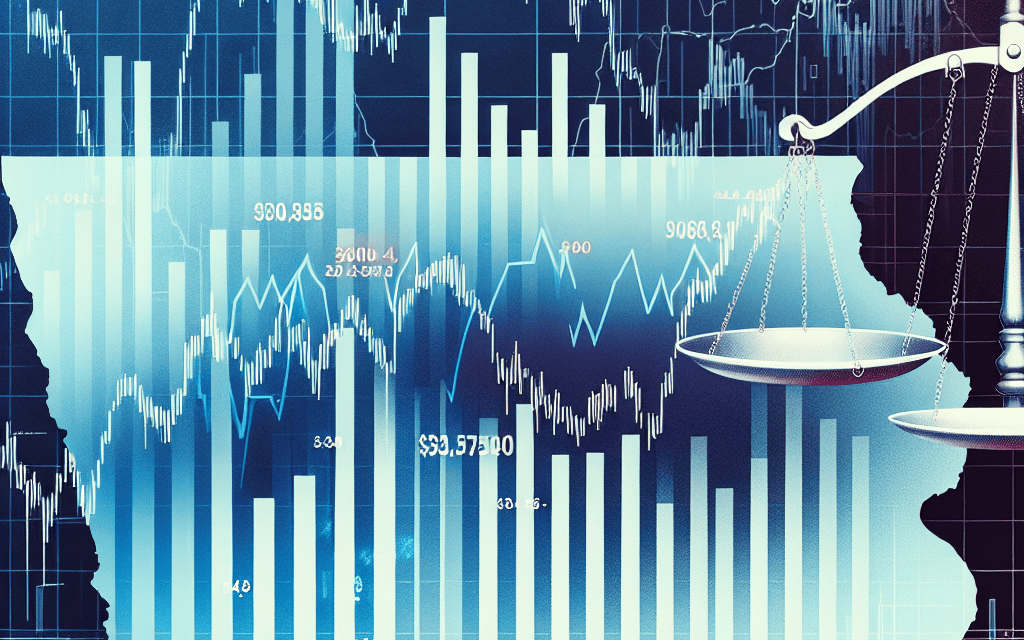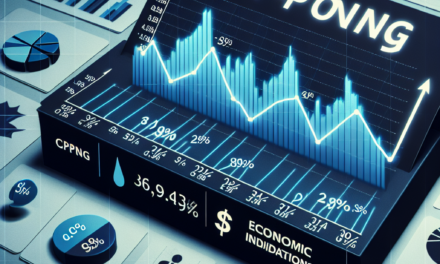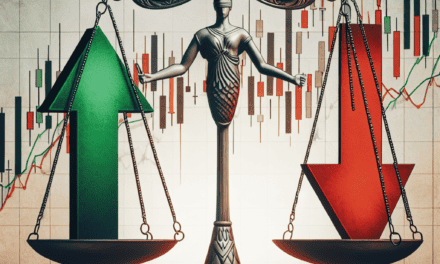“Market Waves: Iowa’s Unexpected Twist Shakes S&P 500 and Nasdaq Futures”
Introduction
The stock market experienced notable fluctuations as S&P 500 and Nasdaq futures reacted to unexpected developments in Iowa, which have cast uncertainty over the so-called “Trump trade.” Investors are closely monitoring the situation, as the political surprise in Iowa has introduced new variables into the market dynamics that have been largely influenced by the policies and rhetoric of the Trump administration. This unforeseen event has prompted a reassessment of market strategies, with traders and analysts evaluating the potential implications for economic policies and their subsequent impact on market performance. As a result, the futures markets are reflecting a period of volatility and adjustment, highlighting the sensitivity of financial markets to political events and their potential to disrupt established trading patterns.
Impact Of Iowa Surprise On S&P 500 And Nasdaq Futures
The recent developments in Iowa have introduced a new layer of complexity to the financial markets, particularly affecting the S&P 500 and Nasdaq futures. As investors digest the implications of the unexpected political shifts, the stock market is experiencing notable fluctuations. The Iowa surprise, which has caught many by surprise, is reshaping the landscape of what has been termed the “Trump Trade,” a market phenomenon characterized by the policies and economic strategies associated with former President Donald Trump. This unexpected turn of events in Iowa has prompted investors to reassess their positions, leading to a ripple effect across major indices.
Initially, the S&P 500 and Nasdaq futures reacted with volatility, reflecting the uncertainty that now permeates the market. The Iowa surprise has introduced a degree of unpredictability, causing investors to reconsider the stability of the economic policies that have been in place. As a result, the futures markets are experiencing a tug-of-war between optimism and caution. On one hand, some investors remain hopeful that the underlying economic fundamentals will continue to support growth. On the other hand, there is a growing concern that the political shifts could lead to policy changes that might disrupt the current economic trajectory.
Moreover, the impact of the Iowa surprise is not confined to domestic markets alone. Global investors are also closely monitoring the situation, as any significant policy shifts in the United States could have far-reaching implications for international trade and economic relations. The interconnectedness of global markets means that fluctuations in the S&P 500 and Nasdaq futures can influence investor sentiment worldwide. Consequently, market participants are keenly observing any developments that might provide clarity on the future direction of U.S. economic policy.
In addition to the immediate market reactions, the Iowa surprise has also sparked a broader discussion about the sustainability of the Trump Trade. Since its inception, this market trend has been driven by expectations of deregulation, tax cuts, and infrastructure spending. However, the recent political developments have raised questions about the longevity of these policies. Investors are now evaluating whether the foundational elements of the Trump Trade will remain intact or if they will be subject to significant revisions.
Furthermore, the Iowa surprise has underscored the importance of political stability in maintaining investor confidence. The stock market thrives on predictability, and any disruption to the status quo can lead to heightened volatility. As such, market participants are closely watching for any signals from policymakers that might indicate a shift in economic strategy. The ability of the market to adapt to these changes will be crucial in determining the future trajectory of the S&P 500 and Nasdaq futures.
In conclusion, the Iowa surprise has introduced a new dynamic to the financial markets, particularly affecting the S&P 500 and Nasdaq futures. As investors navigate this period of uncertainty, the interplay between political developments and economic policy will be pivotal in shaping market outcomes. While the immediate impact has been characterized by volatility, the long-term implications remain to be seen. As the situation continues to evolve, market participants will be closely monitoring any developments that could influence the direction of the Trump Trade and, by extension, the broader stock market.
Analyzing The Trump Trade: How Iowa’s Results Affect Market Trends
The stock market has always been a barometer of economic sentiment, reflecting the collective expectations of investors regarding future economic conditions. Recently, the S&P 500 and Nasdaq futures have experienced fluctuations, a phenomenon that can be attributed to a variety of factors, including political developments. One such development is the surprising outcome of the Iowa caucuses, which has had a notable impact on what is often referred to as the “Trump Trade.” This term describes the market trends that have been influenced by the policies and rhetoric of former President Donald Trump, particularly those related to deregulation, tax cuts, and trade policies.
The Iowa caucuses, traditionally the first major electoral event in the United States presidential primary season, have historically set the tone for the political landscape. This year, the unexpected results have introduced a new layer of uncertainty into the market. Investors, who are always keenly aware of political shifts, have been closely monitoring these developments to gauge their potential impact on economic policies and, consequently, on market trends. The surprise in Iowa has led to a reassessment of the political landscape, prompting investors to reconsider their positions in the market.
In the context of the Trump Trade, the Iowa results have raised questions about the sustainability of the policies that have driven market gains in recent years. The Trump administration’s focus on tax cuts and deregulation has been a significant driver of stock market performance, particularly benefiting sectors such as financials and industrials. However, with the political landscape potentially shifting, there is growing uncertainty about whether these policies will continue to be prioritized. This uncertainty has contributed to the recent fluctuations in the S&P 500 and Nasdaq futures, as investors weigh the potential for changes in economic policy.
Moreover, the impact of the Iowa results extends beyond domestic policy considerations. Trade policies, a cornerstone of the Trump administration’s economic agenda, have also been brought into question. The administration’s approach to trade, characterized by tariffs and renegotiated trade agreements, has had mixed effects on different sectors of the economy. While some industries have benefited from protective measures, others have faced increased costs and supply chain disruptions. The Iowa surprise has led investors to speculate about potential shifts in trade policy, further contributing to market volatility.
In addition to these policy considerations, the Iowa results have also influenced investor sentiment by introducing a new element of unpredictability into the political process. Markets thrive on stability and predictability, and any disruption to these conditions can lead to increased volatility. The unexpected outcome in Iowa has reminded investors of the inherent uncertainties in the political process, prompting a more cautious approach to market participation.
In conclusion, the fluctuations in the S&P 500 and Nasdaq futures can be attributed to the complex interplay of political developments and market expectations. The surprising results of the Iowa caucuses have introduced a new layer of uncertainty into the market, prompting investors to reassess their positions in light of potential changes in economic policy. As the political landscape continues to evolve, it will be crucial for investors to remain vigilant and adaptable, ready to respond to new information and adjust their strategies accordingly. The impact of the Iowa surprise on the Trump Trade serves as a reminder of the intricate relationship between politics and the stock market, highlighting the need for careful analysis and strategic decision-making in navigating these uncertain times.
S&P 500 And Nasdaq Futures: Short-Term Fluctuations Explained
In recent days, the financial markets have been closely monitoring the movements of the S&P 500 and Nasdaq futures, which have exhibited notable fluctuations. These short-term variations can be attributed to a confluence of factors, with the unexpected political developments in Iowa playing a significant role. The surprise impact on what is often referred to as the “Trump trade” has added a layer of complexity to the market dynamics, prompting investors to reassess their strategies.
To begin with, the S&P 500 and Nasdaq futures are often seen as barometers of investor sentiment, reflecting broader economic and political trends. The recent fluctuations can be traced back to the unexpected outcomes in Iowa, which have introduced a degree of uncertainty into the political landscape. This uncertainty has, in turn, influenced market perceptions regarding the stability and predictability of policies that were previously associated with the Trump administration. As a result, investors are now recalibrating their expectations, leading to short-term volatility in the futures markets.
Moreover, the concept of the “Trump trade” has been a significant driver of market behavior since the 2016 election. This term refers to the market’s response to policies and initiatives championed by former President Donald Trump, particularly those related to tax cuts, deregulation, and infrastructure spending. These policies were generally perceived as favorable to business growth and economic expansion, thus boosting investor confidence. However, the recent political developments in Iowa have cast doubt on the continuity of these policies, causing investors to reconsider their positions.
In addition to the political factors, economic indicators have also played a crucial role in shaping the current market environment. Recent data releases have painted a mixed picture of the U.S. economy, with some indicators suggesting robust growth while others point to potential headwinds. For instance, strong employment figures and consumer spending have bolstered optimism about economic resilience. Conversely, concerns about inflationary pressures and supply chain disruptions have tempered this optimism, creating a complex backdrop for market participants.
Furthermore, the global economic context cannot be overlooked when analyzing the fluctuations in S&P 500 and Nasdaq futures. International developments, such as trade tensions and geopolitical uncertainties, continue to exert influence on investor sentiment. The interconnectedness of global markets means that events in one region can have ripple effects across the world, adding another layer of complexity to the decision-making process for investors.
In light of these factors, it is essential for market participants to adopt a nuanced approach when interpreting the recent fluctuations in S&P 500 and Nasdaq futures. While short-term volatility is often unsettling, it is important to recognize that it can also present opportunities for those who are able to navigate the complexities of the market environment. By staying informed and maintaining a long-term perspective, investors can better position themselves to capitalize on potential gains while mitigating risks.
In conclusion, the recent fluctuations in S&P 500 and Nasdaq futures can be attributed to a combination of political, economic, and global factors. The surprise impact of the Iowa developments on the “Trump trade” has introduced a new layer of uncertainty, prompting investors to reassess their strategies. As the market continues to navigate these complexities, a balanced and informed approach will be crucial for those seeking to understand and respond to the evolving landscape.
Iowa’s Political Shifts: Implications For Stock Market Investors

The recent political developments in Iowa have introduced a new layer of complexity to the stock market, particularly affecting the S&P 500 and Nasdaq futures. As investors closely monitor these fluctuations, it is essential to understand the underlying factors contributing to this volatility. The unexpected political shifts in Iowa have cast a shadow over the so-called “Trump trade,” a term used to describe the market trends that emerged following the election of Donald Trump in 2016. These trends were characterized by a surge in stock prices, driven by expectations of deregulation, tax cuts, and infrastructure spending. However, the recent developments in Iowa have prompted investors to reassess their strategies, leading to fluctuations in the futures markets.
To comprehend the implications of Iowa’s political shifts, it is crucial to consider the broader context of the U.S. political landscape. Iowa, often seen as a bellwether state, plays a significant role in shaping national political trends. The state’s recent political surprises have raised questions about the stability of the policies that have underpinned the Trump trade. As a result, investors are now grappling with the potential for policy changes that could impact key sectors such as technology, finance, and manufacturing.
The S&P 500 and Nasdaq futures, which serve as indicators of market sentiment, have been particularly sensitive to these developments. The S&P 500, a broad measure of the U.S. stock market, has experienced fluctuations as investors weigh the potential impact of Iowa’s political shifts on corporate earnings and economic growth. Meanwhile, the Nasdaq, which is heavily weighted towards technology stocks, has also been affected by concerns over regulatory changes and trade policies that could arise from a shifting political landscape.
In light of these uncertainties, investors are increasingly seeking safe havens to protect their portfolios. This has led to a rise in demand for government bonds and other low-risk assets, as market participants attempt to hedge against potential volatility. Additionally, the recent fluctuations in the futures markets have prompted some investors to adopt a more cautious approach, focusing on companies with strong fundamentals and resilient business models.
Moreover, the impact of Iowa’s political shifts extends beyond the U.S. borders, influencing global markets as well. International investors, who closely follow U.S. political developments, are also adjusting their strategies in response to the potential for changes in trade policies and international relations. This has contributed to a broader sense of uncertainty in global financial markets, as investors navigate the complex interplay between politics and economics.
Despite the challenges posed by Iowa’s political surprises, it is important to recognize that the stock market is inherently dynamic and resilient. While short-term fluctuations are inevitable, the long-term outlook for the S&P 500 and Nasdaq remains positive, driven by strong corporate earnings and a robust economic recovery. Investors who maintain a disciplined approach and focus on diversification are likely to weather the current volatility and emerge stronger in the long run.
In conclusion, the recent political shifts in Iowa have introduced a new set of challenges for stock market investors, particularly affecting the S&P 500 and Nasdaq futures. As market participants navigate this uncertain landscape, it is essential to remain informed and adaptable, recognizing that the interplay between politics and economics will continue to shape market trends. By staying vigilant and maintaining a long-term perspective, investors can successfully navigate the complexities of the current market environment.
The Role Of Political Surprises In Stock Market Volatility
The stock market is a complex ecosystem influenced by a myriad of factors, ranging from economic indicators to geopolitical events. Among these, political surprises often play a pivotal role in shaping market volatility. Recently, the S&P 500 and Nasdaq futures have experienced fluctuations, largely attributed to an unexpected political development in Iowa that has impacted what is commonly referred to as the “Trump Trade.” This term broadly encompasses the market trends and investor behaviors that have been associated with the policies and rhetoric of former President Donald Trump.
Political surprises, such as unexpected election results or policy announcements, can lead to significant market volatility. Investors, who often rely on stability and predictability, may react swiftly to such surprises, leading to rapid buying or selling of stocks. In the case of the recent Iowa surprise, the political landscape shifted in a manner that was not anticipated by market analysts. This shift has had a ripple effect on investor sentiment, particularly concerning sectors that were previously buoyed by Trump’s economic policies, such as manufacturing and energy.
The S&P 500 and Nasdaq futures serve as barometers for investor sentiment and market expectations. When these indices fluctuate, it often reflects broader concerns or optimism about economic conditions. The recent fluctuations can be attributed to the uncertainty surrounding the potential implications of the Iowa surprise on future policy directions. Investors are now grappling with questions about how this political development might influence regulatory changes, tax policies, and international trade agreements, all of which are critical components of the Trump Trade.
Moreover, the impact of political surprises on stock market volatility is not limited to domestic markets. Global investors closely monitor U.S. political developments, given the country’s significant influence on the world economy. Consequently, the Iowa surprise has also led to increased volatility in international markets, as investors reassess their portfolios in light of potential changes in U.S. economic policy. This interconnectedness underscores the importance of political stability in maintaining market confidence and highlights the challenges investors face in navigating an ever-evolving political landscape.
In addition to the immediate market reactions, political surprises can have long-term implications for investor strategies. For instance, if the Iowa surprise leads to a shift in policy priorities, sectors that were previously favored may experience a decline, while others may see renewed interest. This necessitates a reevaluation of investment strategies, as investors seek to align their portfolios with the new political and economic realities. Furthermore, the increased volatility may prompt some investors to adopt more conservative approaches, such as diversifying their investments or increasing their holdings in safe-haven assets like gold or government bonds.
In conclusion, political surprises are an inherent aspect of the stock market’s dynamic nature, capable of inducing significant volatility. The recent fluctuations in the S&P 500 and Nasdaq futures, driven by the Iowa surprise, exemplify the profound impact that political developments can have on investor sentiment and market trends. As investors navigate this uncertain terrain, they must remain vigilant and adaptable, continuously reassessing their strategies in response to the evolving political and economic landscape. Ultimately, understanding the role of political surprises in stock market volatility is crucial for making informed investment decisions and mitigating potential risks.
Understanding The Connection Between Political Events And Market Reactions
The intricate relationship between political events and market reactions is a subject of perennial interest to investors and analysts alike. Recent fluctuations in the S&P 500 and Nasdaq futures serve as a compelling case study, particularly in light of the unexpected political developments in Iowa that have sent ripples through the financial markets. Understanding this connection requires a nuanced appreciation of how political uncertainty can influence investor sentiment and, consequently, market dynamics.
To begin with, political events often act as catalysts for market volatility, as they introduce elements of uncertainty that can disrupt the status quo. The Iowa surprise, which has impacted perceptions of the Trump trade, exemplifies this phenomenon. The Trump trade, a term that gained prominence following the 2016 U.S. presidential election, refers to the market’s reaction to policies anticipated under the Trump administration, such as tax cuts, deregulation, and infrastructure spending. These policies were initially perceived as favorable to economic growth, leading to a bullish market sentiment. However, political surprises, such as unexpected election outcomes or policy shifts, can alter these perceptions, prompting investors to reassess their positions.
In the case of the recent Iowa developments, the market’s reaction underscores the sensitivity of financial instruments to political signals. The S&P 500 and Nasdaq futures, which are often seen as barometers of investor confidence, exhibited fluctuations as traders digested the implications of the Iowa surprise. This reaction can be attributed to the potential impact on policy continuity and the broader economic agenda. Investors, wary of the uncertainty, may adopt a more cautious stance, leading to increased volatility in the markets.
Moreover, the interconnectedness of global markets means that political events in one region can have far-reaching effects. The U.S. stock market, being one of the largest and most influential in the world, often sets the tone for global financial markets. Consequently, political developments in the U.S., such as those in Iowa, can trigger a chain reaction, affecting investor sentiment and market performance worldwide. This interconnectedness highlights the importance of political stability and predictability in maintaining market confidence.
In addition to the immediate market reactions, political events can also have longer-term implications for economic policy and market trends. For instance, a shift in political power or policy direction can lead to changes in regulatory frameworks, trade agreements, and fiscal policies, all of which can have profound effects on various sectors of the economy. Investors, therefore, must remain vigilant and adaptable, continuously monitoring the political landscape to anticipate potential market shifts.
Furthermore, it is essential to recognize that while political events can influence market behavior, they are just one of many factors that investors consider. Economic indicators, corporate earnings, and global economic conditions also play critical roles in shaping market trends. As such, a comprehensive approach to market analysis requires integrating political developments with these other factors to form a holistic view.
In conclusion, the recent fluctuations in the S&P 500 and Nasdaq futures in response to the Iowa surprise illustrate the complex interplay between political events and market reactions. By understanding this connection, investors can better navigate the uncertainties inherent in financial markets. As political landscapes continue to evolve, staying informed and adaptable will be key to managing risk and capitalizing on opportunities in an ever-changing market environment.
Strategies For Investors Amid Political Uncertainty And Market Fluctuations
In the ever-evolving landscape of financial markets, investors are constantly seeking strategies to navigate the complexities of political uncertainty and market fluctuations. Recent developments have underscored the importance of adaptability, as the S&P 500 and Nasdaq futures experienced notable fluctuations following unexpected political events. The surprise outcome in Iowa has introduced a new layer of uncertainty, particularly impacting what has been termed the “Trump Trade,” a market phenomenon characterized by policies and economic strategies associated with former President Donald Trump. As investors grapple with these changes, it becomes crucial to explore strategies that can mitigate risks and capitalize on potential opportunities.
To begin with, diversification remains a cornerstone strategy for investors aiming to weather political and market volatility. By spreading investments across various asset classes, sectors, and geographical regions, investors can reduce the impact of adverse events in any single area. For instance, while technology stocks may experience volatility due to policy shifts, sectors such as healthcare or consumer staples might offer more stability. This approach not only helps in managing risk but also positions investors to benefit from growth in different segments of the market.
Moreover, maintaining a long-term perspective is essential in times of uncertainty. Short-term market fluctuations, often driven by political events, can lead to impulsive decision-making that may not align with an investor’s overall financial goals. By focusing on long-term objectives and maintaining a disciplined investment approach, investors can avoid the pitfalls of reacting to temporary market noise. Historical data suggests that markets tend to recover from political shocks over time, rewarding those who remain patient and committed to their investment strategies.
In addition to diversification and a long-term outlook, investors should consider the role of active management in their portfolios. Active managers, with their ability to analyze and respond to market changes, can potentially add value by identifying opportunities and risks that may not be apparent in a passive investment approach. This is particularly relevant in a politically charged environment where policy changes can have significant implications for specific industries and companies. By leveraging the expertise of active managers, investors can better navigate the complexities of the current market landscape.
Furthermore, staying informed about political developments and their potential impact on the markets is crucial for making informed investment decisions. Investors should closely monitor policy announcements, geopolitical events, and economic indicators that could influence market dynamics. By understanding the broader context, investors can anticipate potential market movements and adjust their strategies accordingly. This proactive approach can help in identifying both risks and opportunities, enabling investors to make more informed decisions.
Finally, it is important for investors to maintain a level of flexibility in their strategies. The ability to adapt to changing circumstances is a valuable asset in an unpredictable market environment. This may involve rebalancing portfolios, adjusting asset allocations, or exploring alternative investments that offer different risk-return profiles. By remaining flexible, investors can better position themselves to respond to new information and evolving market conditions.
In conclusion, the recent fluctuations in the S&P 500 and Nasdaq futures, driven by political surprises such as the Iowa outcome, highlight the need for strategic planning in the face of uncertainty. By embracing diversification, maintaining a long-term perspective, considering active management, staying informed, and remaining flexible, investors can navigate the challenges of political uncertainty and market fluctuations with greater confidence. These strategies not only help in managing risks but also open up avenues for potential growth, ensuring that investors are well-prepared for whatever the future may hold.
Q&A
1. **Question:** What recent event has caused fluctuations in the S&P 500 and Nasdaq futures?
– **Answer:** The Iowa surprise impact on Trump trade has caused fluctuations in the S&P 500 and Nasdaq futures.
2. **Question:** How did the Iowa surprise specifically affect the stock market?
– **Answer:** The Iowa surprise created uncertainty in the market, leading to fluctuations in stock futures as investors reassessed the potential impact on Trump-related trade policies.
3. **Question:** What is the significance of the Iowa surprise in relation to Trump trade policies?
– **Answer:** The Iowa surprise may signal a shift in political dynamics that could affect the implementation or continuation of Trump trade policies, impacting investor sentiment.
4. **Question:** How are investors reacting to the Iowa surprise in terms of market strategy?
– **Answer:** Investors are likely adopting a cautious approach, reevaluating their portfolios and considering the potential long-term effects on trade and economic policies.
5. **Question:** What sectors are most affected by the fluctuations in the S&P 500 and Nasdaq futures?
– **Answer:** Sectors closely tied to trade policies, such as technology and manufacturing, are most affected by the fluctuations in the S&P 500 and Nasdaq futures.
6. **Question:** Are there any specific companies that have been notably impacted by these market changes?
– **Answer:** Companies with significant exposure to international trade or those that have benefited from Trump trade policies may be notably impacted, though specific names would depend on the broader market context.
7. **Question:** What are analysts predicting for the future of the stock market in light of the Iowa surprise?
– **Answer:** Analysts are likely predicting increased volatility in the short term, with a focus on political developments and their potential impact on trade and economic policies.
Conclusion
The recent fluctuations in the S&P 500 and Nasdaq futures can be attributed to the unexpected outcomes in Iowa, which have introduced uncertainty regarding the Trump trade policies. This surprise has led to increased market volatility as investors reassess the potential implications for economic and trade policies. The market’s reaction underscores the sensitivity of financial markets to political developments and the importance of closely monitoring such events for future investment strategies. Overall, the Iowa surprise has injected a degree of unpredictability into the markets, highlighting the need for cautious and informed decision-making by investors.





